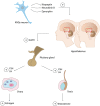Adipokines: A gear shift in puberty
- PMID: 32003144
- PMCID: PMC7317558
- DOI: 10.1111/obr.13005
Adipokines: A gear shift in puberty
Abstract
In this review, we discuss the role of adipokines in the onset of puberty in children with obesity during adrenarche and gonadarche and provide a clear and detailed overview of the biological processes of two major players, leptin and adiponectin. Adipokines, especially leptin and adiponectin, seem to induce an early onset of puberty in girls and boys with obesity by affecting the hypothalamic-pituitary-gonadal (HPG) axis. Moreover, adipokines and their receptors are expressed in the gonads, suggesting a role in sexual maturation and reproduction. All in all, adipokines may be a clue in understanding mechanisms underlying the onset of puberty in childhood obesity and puberty onset variability.
Keywords: adipokines; obesity; puberty.
© 2020 The Authors. Obesity Reviews published by John Wiley & Sons Ltd on behalf of World Obesity Federation.
Conflict of interest statement
The authors declare no conflict of interest.
Figures




Similar articles
-
Is there a causal relationship between obesity and puberty?Lancet Child Adolesc Health. 2019 Jan;3(1):44-54. doi: 10.1016/S2352-4642(18)30306-7. Epub 2018 Nov 14. Lancet Child Adolesc Health. 2019. PMID: 30446301 Review.
-
Inflammatory adipokines, high molecular weight adiponectin, and insulin resistance: a population-based survey in prepubertal schoolchildren.PLoS One. 2011 Feb 18;6(2):e17264. doi: 10.1371/journal.pone.0017264. PLoS One. 2011. PMID: 21365005 Free PMC article.
-
Alterations in markers of bone metabolism and adipokines following a 3-month lifestyle intervention induced weight loss in obese prepubertal children.Exp Clin Endocrinol Diabetes. 2013 Aug;121(8):498-504. doi: 10.1055/s-0033-1347198. Epub 2013 Jun 14. Exp Clin Endocrinol Diabetes. 2013. PMID: 23771796 Clinical Trial.
-
Childhood obesity and central precocious puberty.Front Endocrinol (Lausanne). 2022 Nov 18;13:1056871. doi: 10.3389/fendo.2022.1056871. eCollection 2022. Front Endocrinol (Lausanne). 2022. PMID: 36465655 Free PMC article. Review.
-
Circulating Osteonectin and Adipokine Profiles in Relation to Metabolically Healthy Obesity in Chinese Children: Findings From BCAMS.J Am Heart Assoc. 2018 Dec 4;7(23):e009169. doi: 10.1161/JAHA.118.009169. J Am Heart Assoc. 2018. PMID: 30571596 Free PMC article.
Cited by
-
Evaluation of Glucose Metabolism and Cardiovascular Risk Factors in Prepubertal Girls with Premature Pubarche.J Clin Res Pediatr Endocrinol. 2022 Dec 1;14(4):385-392. doi: 10.4274/jcrpe.galenos.2022.2022-1-1. Epub 2022 May 31. J Clin Res Pediatr Endocrinol. 2022. PMID: 35633646 Free PMC article.
-
Pubarche and Gonadarche Onset and Progression Are Differently Associated With Birth Weight and Infancy Growth Patterns.J Endocr Soc. 2021 Jun 10;5(8):bvab108. doi: 10.1210/jendso/bvab108. eCollection 2021 Aug 1. J Endocr Soc. 2021. PMID: 34250379 Free PMC article.
-
A disturbed communication between hypothalamic-pituitary-ovary axis and gut microbiota in female infertility: is diet to blame?J Transl Med. 2025 Jan 21;23(1):92. doi: 10.1186/s12967-025-06117-x. J Transl Med. 2025. PMID: 39838491 Free PMC article. Review.
-
Pro- and anti-inflammatory adipokines are associated with cardiometabolic risk markers in Brazilian schoolchildren.Eur J Pediatr. 2021 Sep;180(9):2931-2941. doi: 10.1007/s00431-021-04040-z. Epub 2021 Apr 9. Eur J Pediatr. 2021. PMID: 33834274
-
Meta-Analysis of Heifer Traits Identified Reproductive Pathways in Bos indicus Cattle.Genes (Basel). 2021 May 18;12(5):768. doi: 10.3390/genes12050768. Genes (Basel). 2021. PMID: 34069992 Free PMC article.
References
-
- Kumar S, Kelly AS. Review of childhood obesity: from epidemiology, etiology, and comorbidities to clinical assessment and treatment. Mayo Clin Proc. 2017;92(2):251‐265. - PubMed
-
- Reinehr T, Roth CL. Is there a causal relationship between obesity and puberty? The Lancet Child & adolescent health. 2019;3(1):44‐54. - PubMed
-
- WorldHealthOrganization . Facts and figures on childhood obesity. 2017.
-
- Guglielmi V, Sbraccia P. Obesity phenotypes: depot‐differences in adipose tissue and their clinical implications. Eat Weight Disord. 2018;23(1):3‐14. - PubMed
Publication types
MeSH terms
Substances
LinkOut - more resources
Full Text Sources
Medical

